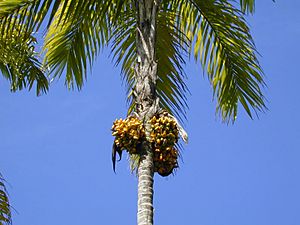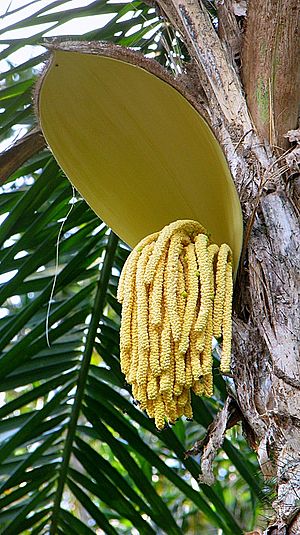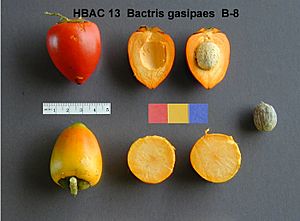Peach palm facts for kids
Quick facts for kids Peach palm |
|
|---|---|
 |
|
| Scientific classification | |
| Genus: |
Bactris
|
| Species: |
gasipaes
|
| Distribution of Bactris gasipaes. | |
| Synonyms | |
|
Guilielma gasipaes (Kunth) L.H.Bailey |
|
The peach palm (Bactris gasipaes) is a type of palm. It grows naturally in the tropical forests of Central and South America. This palm is very common in these areas.
People often grow peach palms on small farms. They might plant them with other crops, which is called agroforestry. Sometimes, they grow only peach palms in one area. The peach palm is a plant that lives for a long time. It can produce fruit for 50 to 75 years.
There are many different types of peach palms. This means their fruits come in various colors and have different qualities. The fruits are good to eat and full of nutrients. But you need to cook them for a while, from 30 minutes to five hours. Wild animals also enjoy eating these fruits.
People also grow peach palms for their heart of palm. This is a tasty vegetable found inside the stem. The trunk of the tree can also be used to make strong wood.
Contents
About the Peach Palm
The peach palm usually grows straight up. It can have one thin stem or several stems growing together. These stems can be up to 20 centimeters (8 inches) thick. Most peach palms have sharp, black spines. These spines grow in circles from the bottom to the top of the stem. Some peach palms have very few spines.
This palm tree can grow very tall, often over 20 meters (65 feet). The trunk has a hard outer layer of black fibers. Inside, it's a lighter brown color. The fibers are packed tightly near the outside of the trunk. They become less dense towards the center. The very middle of the tree is soft.
The leaves of the peach palm are long, about 3 meters (10 feet). They have many small leaflets, like a feather. Each leaf grows on a stem called a petiole, which is about 1 meter (3 feet) long.
The fruit is a type of fruit called a drupe. It has a soft, edible part around a single seed. The fruits are usually 4–6 cm (1.5–2.5 inches) long and 3–5 cm (1–2 inches) wide. When the fruit is ripe, its skin can be red, yellow, or orange. The color depends on the type of peach palm.
Where Peach Palms Grow
Peach palms grow well in many different soils. They can even grow in poor or acidic soils. This is because tiny fungi called mycorrhizas help them. These fungi help the palm get nutrients from the soil.
The peach palm likes warm, rainy climates. It needs between 2,000 and 5,000 millimeters (78 to 197 inches) of rain each year. The average temperature should be warmer than 24°C (75°F). For growing them on farms, altitudes from sea level up to 900 meters (2,950 feet) are best. Sometimes, you can find them higher, up to 1,800 meters (5,900 feet).
The peach palm is a very important plant in the Neotropics. This is a region that includes Central and South America. You can find both wild and farmed peach palms here. They grow in Central America, along the Pacific coasts of Colombia and Ecuador. They are also found in Venezuela and the Amazon rainforest, especially near the Andes mountains.
No one knows exactly where the cultivated peach palm first came from. But it grows in many places because it can adapt to different conditions. It thrives in both tropical and subtropical areas.
Peach Palm Varieties and Reproduction
Wild and farmed peach palms have many different genes. This variety can be helpful for growing new types of palms. Scientists divide peach palms into two main groups. One group is found in Central America and the Andes. The other group is found in the Amazon region.
The western peach palms often have harder stems. They also have more and stronger spines. Their leaves are larger, and their roots are stronger when they are young.
Peach palms usually reproduce by mixing genes from two different plants. This is called outcrossing. But sometimes, a plant can fertilize itself. Small beetles are the main helpers for pollination. They carry pollen between plants, often over distances of 100 to 500 meters (330 to 1,640 feet). Wind and gravity can also help spread pollen.
Because peach palms live a long time and usually mix genes, their populations have a lot of genetic variety. Birds and small animals likely help spread the seeds locally. Water might carry seeds longer distances sometimes.
Wild peach palm populations are in danger. Forests are being cut down for farms and grasslands. Many wild peach palm groups are now separated from each other. This can make it harder for them to reproduce. Wild peach palms often grow alone or in small numbers. You can find them in disturbed areas, along rivers, or in gaps in old forests.
Growing Peach Palms
How Peach Palms Were Farmed Long Ago
People in the Americas started growing Bactris gasipaes a very long time ago. This was before Christopher Columbus arrived. There are different ideas about where peach palms were first farmed. It might have been in the southwestern Amazon. Or it could have been in the valleys of Colombia. Some think it was farmed in many different places.
In ancient times, people used the peach palm for many things. They ate the fruits and seeds. They used the roots as medicine. The wood was very strong and dense. It was used for bows, arrows, fishing poles, and building houses. The spines were used as needles. The leaves were used for roofs and baskets.
At first, people might have used the tree mostly for its wood. But later, they grew it mainly for its starchy and oily fruits. Today, the heart of palm is a very valuable part of the plant.
Modern Farming Methods
Peach palms grow quickly when they are young. They can grow 1.5 to 2 meters (5 to 6.5 feet) each year. They don't block too much sunlight if planted correctly. This makes them good for agroforestry, where different crops grow together.
On farms, peach palms are often grown with coffee and bananas in Costa Rica. In other countries, they are grown with pineapples, papayas, passion fruit, corn, cassava, and cacao. Peach palms start producing fruit about three to five years after planting. They can keep producing for 50 to 75 years. The tree reaches its best production after about seven years.
Peach palms need certain nutrients to grow well. The amount of fertilizer depends on the soil. Farmers often use methods from growing other palms. Phosphorus is a very important nutrient for peach palms. Yields are often better with enough phosphorus and magnesium, rather than just nitrogen.
Using Peach Palm for Animal Feed
Peach palm fruit is often used to feed animals. It has little fiber and a lot of starch. This means it can replace maize (corn) in animal food mixes. The fruits can be stored as silage. This avoids needing to dry or heat-treat them.
However, peach palm silage needs more protein. This makes it better for feeding cattle. Peach palm fruit can also feed fish, chickens, and pigs. It can even be used to make special nutrient blocks for cows, goats, and sheep.
Pests and Diseases
Peach palm trees can get sick from different things. The trunk can be infected by Phytophthora, which are water molds. The leaves can get diseases from fungi like Pestalotiopsis and Mycosphaerella. The fruit can be attacked by fungi such as Monilinia. Other problems include mites and insects like Metamasius hemipterus.
Eating Peach Palms
People have eaten Bactris gasipaes for hundreds of years. When Spanish explorers came to Costa Rica, they found a large peach palm farm. It had 30,000 trees. The fruit from these trees was a main food source for the local people.
To eat the fruit, it is usually cooked in salted water. Then, you peel it and take out the seed. You can add salt or honey for flavor. The cooked fruit feels like a firm sweet potato. Its taste is often compared to hominy, dry squash, or roasted chestnut. In some places, people fill the fruit halves with mayonnaise or sour cream.
Raw peach palm fruit has tiny crystals that can irritate your mouth. But these crystals disappear when the fruit is cooked well. Street vendors often cook the fruit for five hours the night before selling it. However, new studies show that cooking it for 30 minutes in a pressure cooker works just as well. Even less time is needed in dry ovens or microwaves. This cooking method does not change the taste much.
Raw peach palm fruit spoils quickly. But it can be dried and made into flour. It can also be made into preserves or edible oil. In southern Colombia, peach palm chips are made. Many people think these chips could become very popular.
The peach palm is also harvested for its heart of palm. This part grows quickly. The first harvest can happen just 18 to 24 months after planting. Brazil has a big market for heart of palm. The demand for it is also growing around the world.
Peach palm is a good choice to replace other sources of heart of palm. Some native palm species, like Euterpe oleracea and Euterpe edulis, have been over-harvested. The peach palm can help protect these threatened species. It could also replace the endangered Fiji sago palm.
History of the Peach Palm
During the Spanish colonization of the Americas, a sad event happened in Costa Rica. The Spanish cut down 20,000 peach palms. They did this to weaken and control the local people.
The American writer David Brin also mentions the peach palm. He wrote about it in his novel called Earth.
Names for the Peach Palm
The peach palm has many different names around the world:
- chonta or chontaduro (Ecuador)
- chontaduro (Colombia)
- pejibaye (Costa Rica and the Dominican Republic)
- manaco (Guatemala)
- pijibay, supa (Nicaragua and Honduras)
- pijuayo (Peru)
- pijiguao (Venezuela)
- tembé (Bolivia)
- pixbae or pivá/pifá (Panama)
- peewah (Trinidad and Tobago)
- pupunha (Brazil)
- cor wary, supa (San Andrés archipelago)
In an old language called Proto-Tucanoan, the name for pupunha was likely *ɨne.
See also
 In Spanish: Pejibaye o chontaduro para niños
In Spanish: Pejibaye o chontaduro para niños






